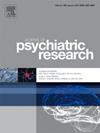Functional connectivity and cerebral cortex activation during the resting state and verbal fluency tasks for patients with mild cognitive impairment, Lewy body dementia, and Alzheimer's disease: A multi-channel fNIRS study
IF 3.7
2区 医学
Q1 PSYCHIATRY
引用次数: 0
Abstract
Objective
To explore changes in cerebral cortex activation and functional connectivity during resting-state and verbal fluency tasks in patients with different types of dementia.
Methods
We recorded oxygenated hemoglobin concentration (HbO) signals detected by functional near-infrared spectroscopy (fNIRS) from the prefrontal cortex, partial parietal cortex, and cortex of the temporal lobe in four groups of participants: mild cognitive impairment (MCI), Lewy body dementia (LBD), Alzheimer's disease (AD), and cognitively normal (CN).
Results
The study recruited 120 older adults with MCI (n = 30), LBD (n = 28), AD (n = 30), or CN (n = 32). The mean functional connectivity of the frontal and temporal lobe in resting state was significantly less in the AD (0.19 ± 0.11) group than in the MCI (0.23 ± 0.11), LBD (0.29 ± 0.12), and CN (0.40 ± 0.11) groups (p < 0.001). Further, the mean HbO concentrations in the brain regions and channels were significantly lower in the AD group than in the LBD and MCI groups (p < 0.001). Cognitive levels correlated significantly with the mean HbO concentrations in the resting state and verbal fluency task conditions.
Conclusion
The fNIRS HbO signals significantly differed in the cerebral cortex regions in participants with different types of dementia. These findings suggest that fNIRS can effectively enhance the differential diagnosis and assessment of dementia.
轻度认知障碍、路易体痴呆和阿尔茨海默病患者在静息状态和语言流畅性任务中的功能连接和大脑皮层激活:多通道 fNIRS 研究。
目的探讨不同类型痴呆症患者在静息状态和言语流畅性任务中大脑皮层激活和功能连接的变化:我们通过功能性近红外光谱(fNIRS)记录了轻度认知障碍(MCI)、路易体痴呆(LBD)、阿尔茨海默病(AD)和认知正常(CN)四组参与者的前额叶皮层、部分顶叶皮层和颞叶皮层的含氧血红蛋白浓度(HbO)信号:研究招募了 120 名患有 MCI(30 人)、路易体痴呆(28 人)、AD(30 人)或 CN(32 人)的老年人。在静息状态下,AD 组(0.19 ± 0.11)额叶和颞叶的平均功能连通性明显低于 MCI 组(0.23 ± 0.11)、LBD 组(0.29 ± 0.12)和 CN 组(0.40 ± 0.11)(P 结论:AD 组的额叶和颞叶功能连通性明显低于 MCI 组(0.23 ± 0.11)、LBD 组(0.29 ± 0.12)和 CN 组(0.40 ± 0.11):不同类型痴呆症患者大脑皮层区域的 fNIRS HbO 信号存在显著差异。这些研究结果表明,fNIRS 可以有效地提高对痴呆症的鉴别诊断和评估。
本文章由计算机程序翻译,如有差异,请以英文原文为准。
求助全文
约1分钟内获得全文
求助全文
来源期刊

Journal of psychiatric research
医学-精神病学
CiteScore
7.30
自引率
2.10%
发文量
622
审稿时长
130 days
期刊介绍:
Founded in 1961 to report on the latest work in psychiatry and cognate disciplines, the Journal of Psychiatric Research is dedicated to innovative and timely studies of four important areas of research:
(1) clinical studies of all disciplines relating to psychiatric illness, as well as normal human behaviour, including biochemical, physiological, genetic, environmental, social, psychological and epidemiological factors;
(2) basic studies pertaining to psychiatry in such fields as neuropsychopharmacology, neuroendocrinology, electrophysiology, genetics, experimental psychology and epidemiology;
(3) the growing application of clinical laboratory techniques in psychiatry, including imagery and spectroscopy of the brain, molecular biology and computer sciences;
 求助内容:
求助内容: 应助结果提醒方式:
应助结果提醒方式:


